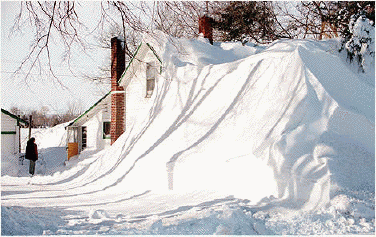| |

Code and Numerical Aspects
Currently, the Piektuk model is coded only in Fortran 77 and can operate on PCs and/or Unix-based machines. The code is approximately 375 lines long and is available in two formats: 1) a non-steady, column version and 2) a steady-state, fetch-dependent version. The vertical coordinate system is equidistant on a logarithmic scale, allowing higher resolution near the surface. Typically, 24 vertical levels are used, with the model lid situated 1 km above the surface. The required meteorological forcing data consists of the air temperature, humidity, wind speed, and atmospheric pressure. A complete listing of variables, parameters and constants for Piektuk is given below. Comments and suggestions on how to improve the code are welcomed.
Modifications
To suit your purposes, modifications to the code may be required such as the following:
- The timestep (time) at which meteorological forcing data is available (currently set to 1800 s).
- The height (zi) of the humidity measurements (currently set to 1.24 m).
- The wind speed threshold (U10t) for blowing snow transport (currently estimated following Li and Pomeroy (1997)).
- The input variable of relative humidity with respect to ice can be modified to other humidity variables.
- Other output files can be created to observe the behaviour of additional model variables and/or parameters.
Please Note!
- The timestep (time) at which meteorological forcing data is available (currently set to 1800 s).
- The height (zi) of the humidity measurements (currently set to 1.24 m).
- The wind speed threshold (U10t) for blowing snow transport (currently estimated following Li and Pomeroy (1997)).
- The input variable of relative humidity with respect to ice can be modified to other humidity variables.
- Other output files can be created to observe the behaviour of additional model variables and/or parameters.
Model Variables
- dN - tendency for N (/m3/s)
- E - tendency for water vapour (kg/kg/s)
- N - total number concentration of particles (/m3)
- p - surface atmospheric pressure (Pa)
- Q - tendency for temperature (K/s)
- qb - blowing snow mixing ratio (kg/kg)
- Qs - sublimation rate of blowing snow (mm/d)
- Qt - transport rate of blowing snow (kg/m/s)
- QTTs - cumulative sublimation rate (mm)
- QTTt - cumulative transport rate (kg/m)
- qv - water vapour mixing ratio (kg/kg)
- RHi - relative humidity wrt ice
- s - steady-state analytical solution to qb (kg/kg)
- Sb - tendency for blowing snow mixing ratio (kg/kg/s)
- Ta - air temperature (K)
- U10 - horizontal wind speed at 10 m (m/s)
- U10t - threshold wind speed for transport (m/s)
Model Constants
- alpha - shape parameter of the gamma distribution
- ar - average radius of blowing snow particles in saltation layer (m)
- cp - heat capacity of air (J/kg/K)
- D - diffusivity of water vapour in air (m2/s)
- deltar - bin size (m)
- dice - density of ice (kg/m3)
- dt - timestep (s)
- g - gravitational constant (m/s2)
- kappa - von Karman's constant
- Kt - thermal conductivity of air (W/m/K)
- lmax - limiting paramter for the eddy diffusivity (m)
- m - fifth moment of gamma distribution
- m2 - second moment of gamma distribution
- Ls - latent heat of sublimation (J/kg)
- pi - Pi
- Rd - gas constant for air (J/kg/K)
- Rv - gas constant for water vapour (J/kg/K)
- rhow - density of water (kg/m3)
- t - time (s)
- time - time interval at which met. data is available (s)
- T0 - freezing point (K)
- visc - viscosity (m2/s)
- zi - height of humidity measurements (m)
- zlb - lower model boundary (m)
- zub - upper model boundary (m)
- z0 - momentum roughness length (without blowing snow) (m)
Model Parameters
- beta - scale parameter of gamma distribution (m)
- ei - saturation vapour pressure over ice (Pa)
- F - particle frequencies for multiple bins in saltation layer (/m3)
- Fd - diffusion parameter for phase change equation (m s/kg)
- Fk - conductivity parameter for phase change equation (m s/kg)
- Km - eddy diffusivity for momentum (m2/s)
- l - mixing length (m)
- Nu - Nusselt number
- qbsalt - saltation mixing ratio (kg/kg)
- Qext - extinction coefficient
- qis - ice saturation mixing ratio (kg/kg)
- Qsalt - saltation transport rate (kg/m2/s)
- Re - Reynolds number
- rho - air density (kg/m3)
- rhop - unit conversion parameter
- rm - mean radius of particle distribution (m)
- ueff - effective friction velocity (m/s)
- ustar - friction velocity (m/s)
- usthr - threshold friction velocity (m/s)
- usalt - saltating particle velocity (m/s)
- vis - optical visibility (m)
- vt - terminal velocity of particles (m/s)
- xi - sublimation parameter (m2/s)
- zr - reference height in saltation layer (m)
- zsalt - height of saltation layer (m)
|
|


